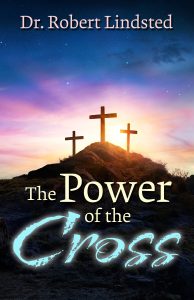Excerpt from The Power of the Cross by Rob Lindsted
Sometimes, as we look at the aspects of the cross, we say almost in an apologetic way, “Jesus died on the cross.” But the Apostle Paul would say this, “God forbid that I should glory, save in the cross of our Lord Jesus Christ, by whom the world is crucified unto me, and I unto the world” (Galatians 6:14).
The crucifixion looked like a dark moment for Christianity. Here was the One that many had followed, and some even thought was the Messiah. But, lo and behold, He was crucified between two thieves. He had a perfect way to get out of the trial, but He did not do it. He offered no defense. He was beaten. He was disfigured. He was nailed to a cross. He was gored with a spear, and He was dead.
It looked like it was the end of Christianity. Thank God, it was only the beginning.
The story of resurrection is not the story of death. It is not the story of reincarnation. Resurrection is completely unique to Christianity.
It is the only hope for eternal life with God. The world sees the grave, but to a believer who has accepted Jesus Christ, death is the bridge that carried Him to glory.
What better way to prove it was glory, not the grave, than by four categories?
- The exact fulfillment of Scripture. He fulfilled Scripture when He died, when He was buried, and when He rose again.
- How the funeral proceeded, and how He arose from the dead.
- The guarding of the tomb.
- The reaction of the spectators as they watched his death and the events in nature showed glory, not the grave.
John 19:38-42 and 20:1-8 say,
And after this, Joseph of Arimathaea, being a disciple of Jesus, but secretly for fear of the Jews, besought Pilate that he might take away the body of Jesus: and Pilate gave him leave. He came therefore, and took the body of Jesus. And there came also Nicodemus, which at the first came to Jesus by night, and brought a mixture of myrrh and aloes, about an hundred pound weight. Then took they the body of Jesus, and wound it in linen clothes with the spices, as the manner of the Jews is to bury.
Now in the place where he was crucified there was a garden; and in the garden a new sepulchre, wherein was never man yet laid. There laid they Jesus therefore because of the Jews’ preparation day; for the sepulchre was nigh at hand.
The first day of the week cometh Mary Magdalene early, when it was yet dark, unto the sepulchre, and seeth the stone taken away from the sepulchre. Then she runneth and cometh to Simon Peter, and to the other disciple, whom Jesus loved, and saith unto them, They have taken away the Lord out of the sepulchre, and we know not where they have laid him. Peter therefore went forth, and that other disciple, and came to the sepulchre. So they ran both together: and the other disciple did outrun Peter, and came first to the sepulchre. And he stooping down, and looking in, saw the linen clothes lying; yet went he not in. Then cometh Simon Peter following him, and went into the sepulchre, and seeth the linen clothes lie, And the napkin, that was about his head, not lying with the linen clothes, but wrapped together in a place by itself. Then went in also that other disciple which came first to the sepulchre, and he saw, and believed.
The fulfillment of Scripture points to glory, not the grave. When death comes in a natural way, it stops things that have been started and they can never be finished. Death puts a halt on all the things we would have liked to accomplish. That is one reason that even believers fear death. But this was not true of Jesus.
Death did not surprise him. Death could never rob Him.
So, as we look at John 19, we see one of the ways that glory is given to God is in the great fulfillment of Scripture concerning the details of His death.
One of the Scriptures that was fulfilled was Psalm 22:18, “They part my garments among them and they cast lots upon my vesture.”
We saw in John 19:24 that this was exactly what happened. Some 1,500 years before Christ ever went to the cross, the Old Testament records that they would take His garments and for some they would divide them, and for others they would cast lots.
He also died at just the right moment. In Deuteronomy 21:22-23 we read,
“And if a man has committed a sin worthy of death, and is to be put to death, and thou hang him on a tree: His body shall not remain all night upon the tree, but thou shalt in any wise bury him that day; ( for he that is hanged is accursed of God;) that thy land be not defiled, which the Lord thy God giveth thee for an inheritance.”
In John 19:31 the Jews say,
“… because it was the preparation, that the bodies should not remain upon the cross on the Sabbath day …”
They wanted to crucify Christ but keep the law. They wanted to keep the Passover, but they refused to see the Passover Lamb … Christ.
I believe Christ died of a broken heart. We read in Psalm 69:20, “Reproach hath broken my heart; and I am full of heaviness: and I looked for some to take pity, but there was none; and for comforters, but I found none.”
There He was on the cross. He looked for His disciples. They were gone. He looked for comfort among man. There was none.
He died of a broken heart, but He did it for us, the very ones who forsook Him and fled!
Not only did He die according to Scripture, but He was buried according to Scripture. “And He made His grave with the wicked, and with the rich in His death …” (Isaiah 53:9).
Christ had no money, so how could He be buried with the rich? In John 19, Joseph of Arimathaea arrived on the scene. It is written in verse 38 that, for fear of the Jews, he was a secret disciple. Matthew 27:57 says that he was a wealthy man. We read in John 19 that he begged Pilate for the body of Jesus to bury it.
At that time, a good indication of wealth was how close to Jerusalem a person could afford to be buried. The Bible says that the place He was buried was near to the city.
Joseph of Arimathaea just “happens” to confess the Lord openly at the right moment in order to get the body off the cross and into the tomb so He could be there three days and then come alive again exactly as He said.
If you think that is an accident, you are mistaken! It was all part of the great plan of God.
Another way that glory is shown, and not the grave, was by the guards at the tomb. In Matthew 27:62–66, we find a great story:
Now the next day, that followed the day of the preparation, the chief priests and Pharisees came together unto Pilate, Saying, Sir, we remember that that deceiver said, while he was yet alive, After three days I will rise again. Command therefore that the sepulchre be made sure until the third day, lest His disciples come by night, and steal Him away, and say unto the people, He is risen from the dead: so the last error shall be worse than the first. Pilate said unto them, Ye have a watch: go your way, make it as sure as ye can. So they went, and made the sepulchre sure, sealing the stone, and setting a watch. They rolled a huge stone in front of the tomb and then sealed the stone. Next, they set guards around it so that the body of Jesus could not have been stolen by his disciples.
Then there was the torn veil. Matthew 27:51 says that the veil of the temple was torn in two from the top to the bottom. Hebrews 10 tells us that when Christ’s flesh was torn, the veil was torn. The graves opened. Some of the people got up out of their graves and went back into the city.
Scripture says that darkness came. The sun was created by Him and when He died, the sun went black.
The Earth quaked. The rocks split. I like to think that nature’s heart was broken. Has He broken your hard heart?
He fulfilled Scripture in how He died, how He was buried, how His body was guarded, and how nature rebelled.
Because all these Scriptures were fulfilled, be confident that it was glory, not the grave!

